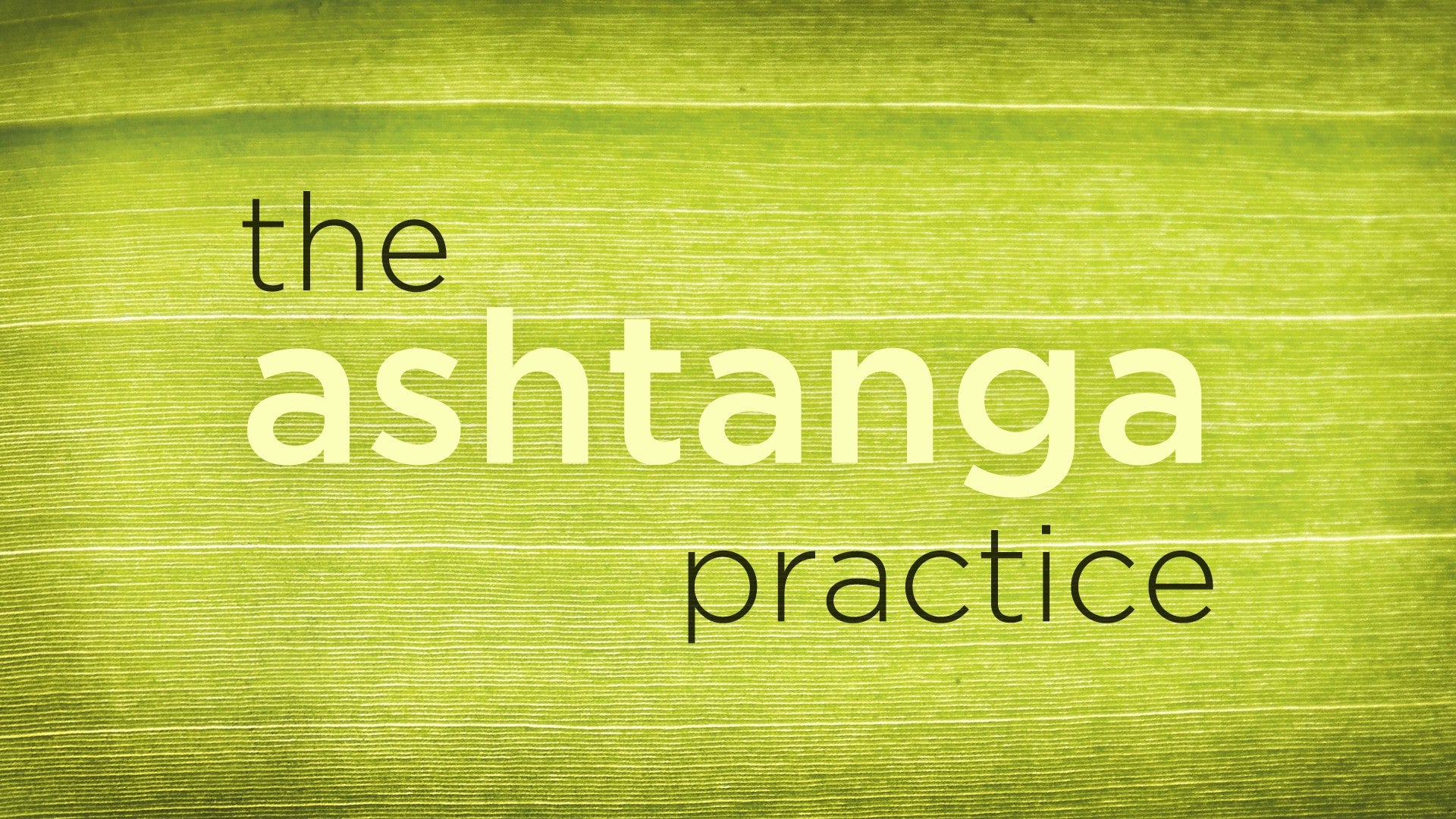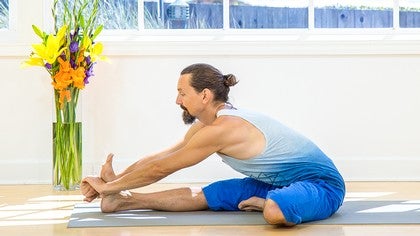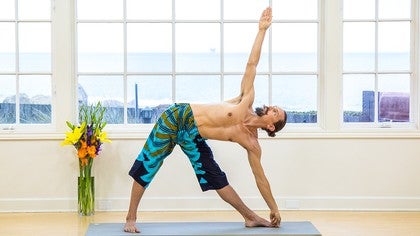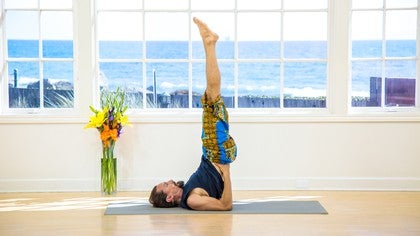Description
About This Video
Transcript
Read Full Transcript
Welcome. One of the primary teachings of the Buddha, so I've heard, was awareness of your breath. And that's something we've become accustomed to in our modern yoga practices. Something we hear all the time, that you should pay attention to your inhale and your exhale. But do we often do it?
Hopefully so. It's really important that we pay attention to the spaces that occur in between the breaths as well. So when Buddha taught, if we look back into the old suttas, we see Anapanasati, awareness of inhale and exhale in the Pali language. He also taught the third and fourth elements of breath were just as important, if not more important to pay attention to the space between the breaths. So in this tutorial, we'll do a little bit of breathing where we find those pauses, and then we'll start to look at how we use them in our transitions of the seated postures, including eventually we'll look at how we jump forward and jump back.
But for now, just be in a seated position with a nice long spine, and take nice long breaths. You can exhale, more breath out, exhaling completely, finding Bandhas if you like. And then as you inhale, feel the chest swelling, the collarbones broadening. And pause, keeping the back of the throat open, begin the exhale slowly, and then allow the breath to come out more quickly. And then pause, inhaling.
So really honor, keep breathing at your own pace, and really honor those spaces that occur in between the breaths. And it's not like you're holding breath. The back of the throat stays open, it's just that you slow down as you reach towards a transitory moment. Think of it as if you had a ball, and you threw it in the air, and you could look through slow motion. And you'd notice that the ball was rising and rising and rising and rising, and at some point it starts to slow down, and at some point it's neither rising nor falling.
And then very slowly it starts to fall, and then it begins falling more rapidly. The same with the breath. As we approach the transitory moment, our breath slows down. We appreciate that moment, neither breathing in nor breathing out. And then the exhale begins.
Same thing at the bottom of the exhale. So just do a few breaths with me here and enjoy. Great as simple as that technique is, it's going to prove really insightful as we put space between the breaths through our entire vinyasa approach. So let's take a look at a simpler position, Janu Sushasana A, somewhere in the middle of the first half of primary series, from Downward-Facing Dog. We begin, sapta, inhale, stepping or jumping, coming through to a seated position, however it's comfortable for you to arrive, but arrive in Dandasana.
Sit there, finish the inhale, and then with your next exhale, you can draw the foot in. I'm going to go right foot first, just like tree, the sole of the foot on the left thigh. Now you've exhaled to make that posture, inhale, reaching forward, wherever it's comfortable, strap, or reaching deeply forward, whatever works, but the inhale lengthens the spine and makes sure that the drishti is gazing towards big toe. And then ashdao, the next count, draws you forward as you fold deeply over the left thigh. Taking your number of breaths here, exhaling completely at your last breath, and then nava inhale, allow the inhale to lift the chest, but keep the hands bound.
So in this position you can even broaden the collarbones, tilting the chest forward, still gazing on the big toe, but finding real length through the whole spine. And then exhale, and release the pose, cross the legs, plant the hands, and dascha, inhale, find some lift off the mat, ekadasha, exhale, step, or jump back to chaturanga, we'll look at how to do that later, dwarasha, inhale, upward facing, triyugdasha, exhale, downward facing dog, chaturgdasha, inhale, step, or jump your feet forward and through, and arrive. And then exhaling, construct the posture, clasp the hand or foot or leg, inhale, lengthen, and pancharasha, exhale, and fold. You'll take your number of breaths here, and still keeping drishti, shursha, inhale, still with the hands bound, lengthening the spine, even pulling on the feet to get really long, and exhale, break the hand grab, break the drishti, saptarasha, inhale, ajdarsa, exhale, jump back, ekuna, vimshatihi, inhale, upward facing dog, vimshatihi, exhale, downward facing dog. Great, so just to recap here, our temptation might be to hustle or to hurry, and if you've been looking at my other tutorials and practicing with me, you know that I'm really interested in restraint, not rushing ahead, but enjoying the ride and enjoying this moment, because truly there is no next pose, there's only this pose, that's the only thing you're working on is right now, so don't lose that in a stronger practice that can help build momentum, don't get caught up in grasping for the next, but instead arrive in dandasana, keep space between the breaths, and let breath guide you through the practice from the inside out.
So there are a variety of ways to jump forward and jump back, and of course when we examine putting spaces between the breath and how our vinyasa transitions work, many people get excited by doing fancy flips and interesting vinyasa transitions. That's okay, that's great. At the same time, the most important thing is that you're following your breath, and it doesn't matter so much if you're doing a big and fancy transition, as much as it is interesting if you can actually use the breath and the vinyasa to guide you back with internal awareness. With that said, let's look at some ways that we jump back. You've taken yourself into and out of a position, fully guided on the breath, and then that exhale gives you this golden moment, this great opportunity where you can push extra breath out as you've learned to do, recruiting muscles of the lower abdomen, even pelvic floor, mula bandha and udiyana bandha, if you will.
You draw the heels in towards the butt, the knees up towards the chest, and squeeze the lower body and the upper body together in a little ball as best you can. Plant the hands with a great firm hand position, the thumbs pulled really far back, grounding through the root knuckle, the index mound, and all that again happens on that exhale. From that great setup and that golden opportunity, then inhale, pressing down through the palms, lifting the hips, lifting the heels, and lifting the knees in towards the chest, and try to get up off the mat. But inhale as you do it, or rather, let the inhale be the cause, so, coming up during the inhale. Inhale doesn't matter if you don't get up off the mat.
If you're having trouble getting both feet off the mat, maybe you can lift the hips, get one foot up off the mat, try the other foot, notice how that activates different muscles in the internal abdominal musculature, and see then, perhaps, if you inhale, come up whichever way is comfortable, and then the exhale will guide you to chaturanga. So even if you're putting the hips down, stepping the feet back, planting the hands at the front corners of the mat, and then walking back, or even a little hop back, try to encapsulate all that during an exhalation. So just to reiterate, I'll show you a modified, or a very workable, jump back, where there's no jumping involved, but the breath count remains the same. Okay, you've come to your chaturanga, inhale upward facing, exhale downward facing dog, and now you'd like to jump through to the other side. With your inhale, you'll want to bend the knees, but tip the hips forward and up.
Still inhaling, you want to practice bringing the hips up above the shoulders, above the wrists. You don't need to pause there, but if you do have the control to bring your hips that far forward, it's going to give you more success in jumping forward. So inhale, lifting the hips up, you can cross the legs if you're comfortable there, and just take a few practice hops. When you come so far forward that the fingertips go white from pressing into the mat. Now practice crossing the legs, right foot behind the left wrist, left foot behind the right wrist, still keeping the hips high so that when you're able to jump forward, you'll cross the legs at the same time, exhaling completely, inhaling the hips up, crossing the legs, and then maybe squeezing back to that little ball, keeping lifted up off the mat, straightening the legs in front.
Now that's a lot to ask. So if it's not happening for you today, don't feel like, oh no, I feel so heavy in this practice to do it. No, by all means, the most important thing is still just following the breath. So as you inhale, you may just lift the hips a little, step one foot, step the other foot, and try to lift up off the mat, then sit, still inhaling, and arrive. Let's practice a jump back and a jump forward, modified as little or as much as you like, but staying on the breath count.
So from whatever position you're in, inhale, long spine, exhale, cross the legs, plant the hands together, the golden moment, inhale and lift up, exhale, step or jump back, and each hadaranga, inhale, upward facing, exhale, downward facing dog, and then with your inhale, step or jump the feet forward, come to a sitting position, and arrive in Dandasana, great. So again, remember, we're not looking at an acrobatic or circus style approach here. What we're trying to do is keep ourselves focusing on our breath. So take just a moment here in sitting, any comfortable seated posture, whatever serves you best, and breathe. Every exhale emptying out, pausing, every inhale, getting completely full and pausing, and as you lengthen the breath, lengthen the spine, and perhaps lengthen the spaces between the thoughts.
Thanks for sharing in this practice, hope you're practicing each day.
The Ashtanga Practice: Dylan Bernstein
Comments

You need to be a subscriber to post a comment.
Please Log In or Create an Account to start your free trial.







